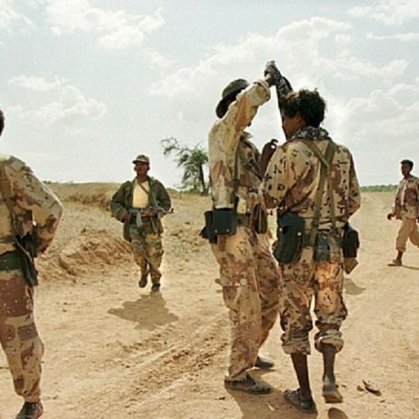ETHIOPIA AND ERITREA DECLARE : END THEIR BITTER WAR.THE 1998-2000 CONFLICT,ERITREAN - ETHIOPIAN BORDER CLASHES.OVER THE EXACT LOCATION OF BORDER LED TO THE DEATHS OF AN ESTIMATED 80,000 PEOPLE.ETHIOPIA BELIEVES THAT ERITREA CHARGES AN EXORBITANT FEE TO EXPORT ETHIOPIAN COFFEE THROUGH THE ERITREAN PORT. ERITREA BELIEVES THAT ETHIOPIA HAS MOVED BORER MARKS TO INFRINGE ON ERITREAN TERRITORY.
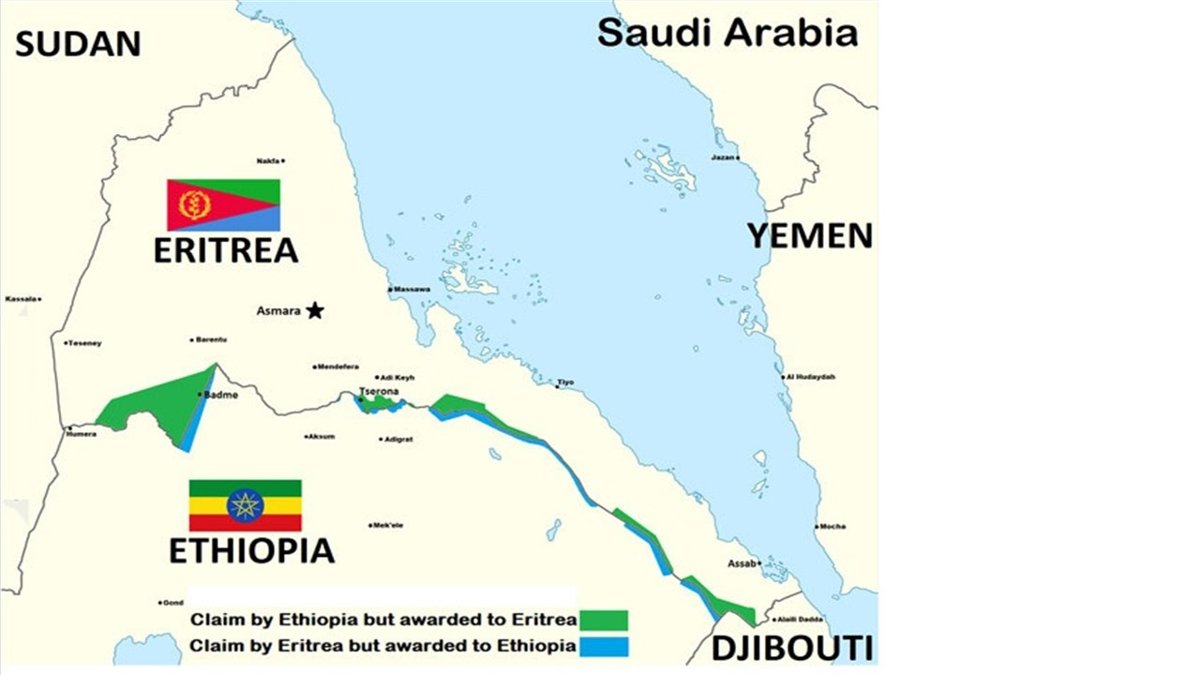 Haphazard solution to the 1998-2000 war.This is the climate in which Eritrea invaded Ethiopian territory in
1998, sparking war. To the Eritrean government, it appeared that the
ruling party in Ethiopia was in a vulnerable position. It ran a poor,
vast, diverse country with a history of strife along various cleavages.The 1998-2000 conflict was lazily framed as a border war ” by the
international community and media. But whatever one calls it, it took
the lives and limbs of tens of thousands of people from both countries.
Haphazard solution to the 1998-2000 war.This is the climate in which Eritrea invaded Ethiopian territory in
1998, sparking war. To the Eritrean government, it appeared that the
ruling party in Ethiopia was in a vulnerable position. It ran a poor,
vast, diverse country with a history of strife along various cleavages.The 1998-2000 conflict was lazily framed as a border war ” by the
international community and media. But whatever one calls it, it took
the lives and limbs of tens of thousands of people from both countries.
Ethiopia and Eritrea have profound historical and cultural ties. But
they also have separate histories , which the political classes of the
two countries play up or down depending on their political aspirations
particularly around the fact that Ethiopia remained independent while
Eritrea was colonised by Italy from 1891-1941 and was subsequently under
British rule from 1941-1952.In December 1950, the United Nations General Assembly voted in favour
of granting Eritrea autonomous federal status under the sovereignty of
the Ethiopian Crown. This was in line with the aspirations of a segment
of the Eritrean population, but another section of society was
vehemently opposed. Eritreans were not given the opportunity to vote on
the issue, however, so it is difficult to determine which side had
greater popular support.Nevertheless, the ongoing federal arrangement proved unsatisfactory
to both unionist and separatist segments, and it was abolished in 1962
when the Eritrean parliament voted for total union with Ethiopia.This decision went directly against the desires of the
pro-independence Eritrean elite, who claim the vote was the result of
interference from Emperor Haile Selassie. In the aftermath of the
decision, a “liberation struggle” was launched. This turned into a
liberation war which combined with the civil war waged by various
Ethiopian groups to unseat the military government in Addis Ababa –
brought untold misery to the people of both countries.Eritrea was once part of the Ethiopian empire, but it was colonized by Italy from 1869 to 1941. Following Italy's defeat in World War II, the Uni ted Nations determined that Eritrea would become part of Ethiopia, though Eritrea would maintain a great deal of autonomy. In 1961 Ethiopia removed Eritrea's independence, and Eritrea became just another Ethiopian province. In 1991 following a revolution i n Ethiopia, Eritrea gained its independence. However, the borders between Ethiopia and Eritrea had never been clearly marked. Following arguments and skirmishes, Eritrea invaded the area of Ethiopia it viewed as its own. Trench warfare and the deaths of ma ny soldiers and civilians has continued since theEthiopia and Eritrea fought a war from May 1998 to June 2000. The war resulted in 100,000 deaths and millions of dollars diverted from much needed development into military activities and weapons procurements. The major reason for the recent conflict is the fact that Ethiopia no longer has a border along the Red Sea and therefore relies on going through other countries such as Eritrea in order to ship and trade goods along that line.In 1974 the Ethiopian Revolution ended the longest ruling monarchy in African history . Haile Selassie, the well - known emperor and statesman, was deposed in a revolution caused by inequality and lack of development and democracy within Ethiopia. The Marxist government that took over power was called the Dergue, which is the Amharic word for committee. (Amharic is the language of Ethiopia.) But what was supposed to be a committee quickly turned into a dictatorship under the control of Mengistu Haile Mariam. Shortly afte r the revolution, Mengistu began to purge the country of dissent in what was called the "Red Terror." Many young people died, others fled the country or joined armed opposition groups in the countryside. Opposition to the state was already going on in the northern province of Eritrea, where fighting dated back to 1961. In 1961 the Ethiopian state abolished any autonomy held by the Eritrean region. Though it was at one point part of the Ethiopian empire, the Italian colonization o f Eritrea from 1869 until 1941 gave it a distinctly different history than the rest of the Ethiopian state, which had never been co lonized. When Italy was defeated in World War II, it was forced to give up its colonies. A United Nations commission decided what should be done with the Italian colonies in Africa: Eritrea, Libya and Italian Somaliland. It was determined that Eritrea shou ld be united with Ethiopia, but that it should be allowed to keep its own laws, flag and language. Eritrea, therefore, had some autonomy from 1952 until 1961, when Haile Selassie decided to end what Eritrean autonomy existed. In 1961 Eritrea was stripped o f its distinctive government and became simply another province of Ethiopia. It was at that time that fighting began between Eritreans who supported complete independence from Ethiopia and the Ethiopian state. Armed opposition to the Ethiopian state contin ued throughout the 1970s and 1980s. Opposition to the Ethiopian government grew during the Ethiopian famine.The leaders of the two countries knew each other and had cooperated with one another in the overthrow of the previous state. Both countries realize d that the border between them had not been properly demarcated and it was assumed that Eritrea's boundaries would be the boundaries it had prior to its incorporation into the Ethiopian state in 1952. But this proved to be a problem because the borders of Eritrea prior to 1952 were not clearly defined. There were multiple maps of the border area, most of which marked the border as a straight line, in spite of the fact that administration of the areas followed the jagged boundary of a river. Perhaps because the Italians always desired to take over more of Ethiopia, they did n o t clearly identify the southern border of Eritrea. To resolve the confusion regarding the border, Ethiopia and Eritrea formed a border commission in 1993 to discuss the border problem. T he commission met from 1993 through 1997, but conflicts between local peoples in the border areas continued during this period. At issue was the question of who had the right to farm the territory. Eritrean people complained of harassment and fines imposed by Ethiopian officials and the confiscation of animals. Neither side seemed certain which farmers Ethiopians or Eritreans should be able to plant crops. Serious economic problems between the two countries began in 1997. Ethiopia was, at that point, already angry with Eritrea about what Ethiopia viewed to be excessively high port charges to export its coffee crop through Assab. The t wo countries shared a common currency, the Ethiopian birr, and Ethiopia was upset that Eritrea was using birr to acquire dollars and thereby tightening the money supply in both countries. In 1997, Eritrea came out with its own currency called the nakfa. Ethiopia insisted that interstate transactions be conducted in dollars, which put economic pressure on Eritrea as it then had to pay for imports of food and other Ethiopian resources in dollars.Ethiopia is a Compact State isolated by land. A potential problem an isolated compact state is conflict prompted by a lack oceanic access in order to export and import goods. Anther problem of a compact state is a lack of arable space for farming. Especially in modern societies where importing goods increases the carrying capacity.Ethiopia has established a strict no-fly zone along its frontier with Eritrea since a bitter conflict broke out between the two countries in May 1998 over the control of border areas.
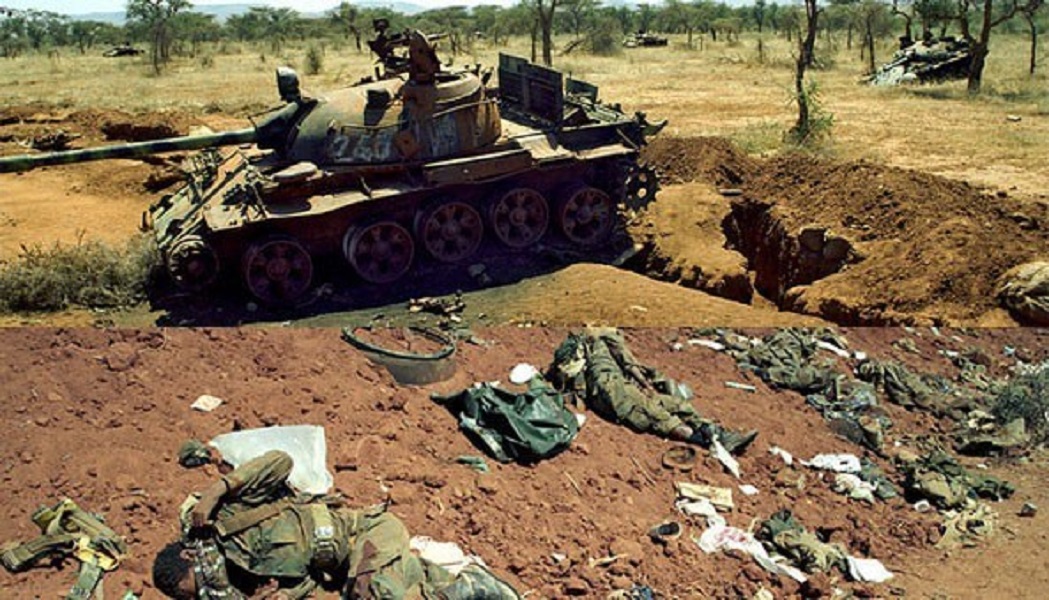
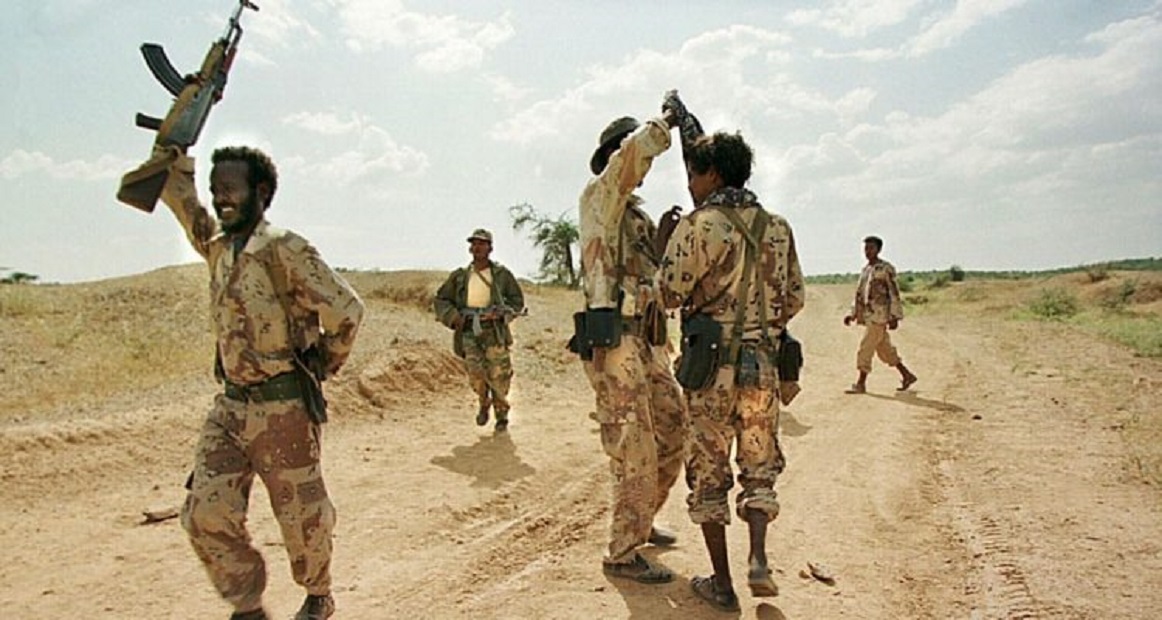 The war finally ended with the Algiers Peace Treaty. This was
signed after Ethiopia had regained all the contested territories and
penetrated deep into Eritrean territory, but unfortunately the parties
and mediators that facilitated this agreement took a purely legalistic
approach to resolving the conflict. The real underlying causes of the
conflict were swept under the carpet, and the focus was on determination
of the boundary between the two states – the most superficial of the
causes of the conflict. Each side won and lost some territory.
The war finally ended with the Algiers Peace Treaty. This was
signed after Ethiopia had regained all the contested territories and
penetrated deep into Eritrean territory, but unfortunately the parties
and mediators that facilitated this agreement took a purely legalistic
approach to resolving the conflict. The real underlying causes of the
conflict were swept under the carpet, and the focus was on determination
of the boundary between the two states – the most superficial of the
causes of the conflict. Each side won and lost some territory.
Ethiopian government the issue is one of defending against this and any possible future Eritrean incursions into their territory. Few people outside of those living in the Horn of Africa , an eastern outcropping on the continent of Africa including the countries of Ethiopia, Eritrea, Somalia and Djibouti, and a few academic experts understand why these countries are fighting, but the whole world has remarked upon the p articular brutality of this war. The Ethiopian - Eritrean border war has attracted international attention for the tactics used by each side. A fter taking a few miles of Ethiopian territory, the Eritrean army dug in and began to use trench warfare to defend their territoria l acquisitions. In response the Ethiopian army used the time - honored method for combating trench warfare rushing the trenches in human waves in order to capture the enemy. This method of fighting has led to a large and mounting death toll on both sides. Th ough the numbers are disputed, it is estimated that seventy thousand soldiers from both sides have died. The rest of the world has been stunned by methods of fighting that have not been used for such an extended period of time since World War I. In additio n to the staggering death toll, this war has also been characterized by the use of land mines against both combatants and civilians. When the Eritrean army retreated from the territory it had captured initially, it left fields and scrubland filled with landmines, making farming impossible and a re - establishment of the Ethiopian administration difficult. Ecologically, the effects of this war will be felt for years, both because of the presence of so many landmines and due to the effect that the fighting has had on the fragile, semi - arid ecosystem, now polluted with shell casings, wrecked military equipment and the refuse of two armies. Prior to the war, relations between the two countries had been friendl y enough that many Eritreans lived in Ethiopia the larger country with more economic.Fighter jets belonging to the Ethiopian military make frequent sorties against Eritrean troops, while anti-aircraft posts are dotted along the border. Meles Zenawi has been the head of the Ethiopian government since 1991 when the EPRDF overthrew the government of dictator Mengistu Haile Mariam. He became prime minister of the c urrent government of Ethiopia in 1995 after his party won elections under the new Ethiopian constitution. Prime Minister Meles, as he is properly called in Ethiopia where a person's last name is simply their father's first name, was born Legesse Zenawi. He comes from the Tigray region of Ethiopia, from the town of Adwa, a historic and revered site in Ethiopia. Adwa is the place where the Ethiopian army was able to fend off Italian colonization efforts in 1896. Zenawi went to high school in Addis Ababa and s tarted college where he studied medicine. The Ethiopian Revolution occurred in 1974 and Meles interrupted his studies to fight against the government of Mengistu Haile Mariam. He joined an organization that was later to become the Tigrayan People's Liberation Front or TPLF. The TPLF is curren tly the dominant party in the coalition of parties that makes up the EPRDF. Zenawi is known as being both bright and energetic. He earned a masters degree after the 1991 success of the rebels. He collaborated with Issayas Afeworki, now president of Eritrea , in the attempt to overthrow the Dergue government. The two were reported to be friends prior to the beginning of tensions that ultimately led to the border war. Issayas Afeworki is also of the Tigrayan ethnic group, though he was raised on the Eritrean s ide of the border. He is well respected for his intelligence and his 'everyman' quality. President Issayas (the Eritreans have the same naming convention as Ethiopians) is known to drive around Asmara (the capital of Eritrea) in an old Toyota and live mode stly with his wife and three children. Issayas Afeworki was active in fighting for Eritrean independence since 1967. He helped to form the Eritrean People's Liberation Front (EPLF) as a joint effort between Muslims and Christians aimed at the independence of Eritrea.As border clashes between Eritrea and Ethiopia continued into the second day on June 13, observers recalled UN Secretary-General’s remarks in January 2008 that he was “worried about the growing militarization, on both side(s) of the boarder, which could lead to a war”.That concern is shared by civil society organisations in the two countries. They are warning that the border clahses that triggered in the Tsorona area on the border of Ethiopia and Eritrea “can easily escalate into full-blown war”.While calling for an end to fighting, the civil society organisations are urging the African Union to step in with its peace and Security Council; and the European Union and the United States to step in as witnesses to a peace process. Europe External Policy Advisors – has associated itself with the call. EEPA’s founding director Prof. Mirjam van Reisen, who is a specialist on the Horn of Africa, said: “Ethiopia and Eritrea have confirmed military clashes in the border area near Tsorona, one of the disputed villages in the border between the two countries where clashes are common for years. It remains to be seen now if there is only an isolated incident.”These reports of clashes come days after the UN Commission of Inquiry presented its conclusions that “crimes against humanity” are widespread in Eritrea and ongoing, van Reisen told IDN. The UN Commission of Inquiry advised the UN Human Rights Council to refer the matter to the UN Security Council.lashes in the border areas do not come as a surprise, added van Reisen. In recent months, both sides have been building up their military presence and the situation on the border has been tense. In fact troop movements are reported to have been taking place on both sides in the Tsorona region.Every month around 5,000 people are fleeing Eritrea. The refugee exodus is haemorrhaging the country. Young people undertake hazardous journeys, risk deportations in the Sudan and face torture, extortion and death in Libya. Only recently, hundreds of Eritreans died in the Mediterranean and many announced the loss of loved ones on social media.
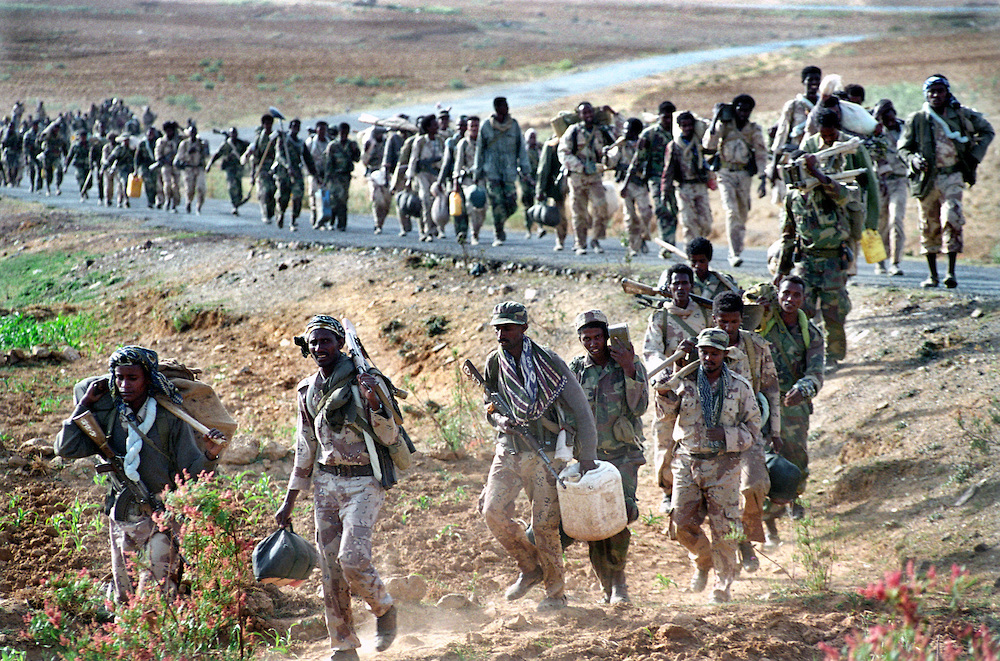 Better explanations of the conflict today refer to the complete
absence of trust between the protagonists, a fear of accountability, and
the lack of vision and resolve to move forwards.Additionally, some point out that the defence of Eritrea’s
sovereignty seems to be the only claim to legitimacy left to the ruling
party. Its interest seems to be in perpetuating the status quo. And in
any case, it seems the goverments in both Eritrea and Ethiopia have
settled for outliving the other side as the only solution.
Better explanations of the conflict today refer to the complete
absence of trust between the protagonists, a fear of accountability, and
the lack of vision and resolve to move forwards.Additionally, some point out that the defence of Eritrea’s
sovereignty seems to be the only claim to legitimacy left to the ruling
party. Its interest seems to be in perpetuating the status quo. And in
any case, it seems the goverments in both Eritrea and Ethiopia have
settled for outliving the other side as the only solution.
Eritrea gained independence from Ethiopia in 1993, however after simply 5 years, the nation started preventing with Ethiopia for management of a number of distant border areas, with tens of hundreds killed. There was a border fee ruling in 2002 that gave disputed territories to Eritrea, however Ethiopia didn’t settle for this resolution.Also other messages on social media are demanding “No to War”. And this against the backdrop that the UN Commission of Inquiry presents a dark picture of the situation in Eritrea. It estimates that between 300,000 and 400,000 people are living in slavery, and finds that the indefinite national service is “a crime against humanity”.All Eritreans over 18 and under 40 must do 12 to 18 months of national service, according to a proclamation that followed Eritrea’s independence from Ethiopia in 1991.But in practice, military service can be extended indefinitely, analysts and human rights groups say.
Up to 25,000 Eritreans leave illegally each year, most crossing into Sudan and Ethiopia to make their way to Europe or the Middle East, diplomats and aid agencies say.Many say they are fleeing national service. Eritrea restricts exit visas and passports of military-eligible men and women under 50 and 47 respectively.The report states that “Crimes against humanity have been committed in a widespread and systematic manner in Eritrean detention facilities, military training camps and other locations across the country over the past 25 years.”The report adds “that the types of gross human rights violations in Eritrea documented by the Commission … are not committed on the streets of Asmara, but rather behind the walls of detention facilities and in military training camps. Torture and rape are not normally perpetrated in the open”.The report states further that “the façade of calm and normality that is apparent to the occasional visitor to the country, and others confined to sections of the capital, belies the consistent patterns of serious human rights violations”.The prospect of war will certainly disrupt the facade of calm, not only in Eritrea but in the entire Horn region, added van Reisen sharing the UN Chief’s apprehension eight years ago.The UN Chief’s concern has been recorded by the Permanent Court of Arbitration in The Hague, which serves as registry for the Eritrea-Ethiopia Boundary Commission established pursuant to the Agreement of December 12, 2000 between the Government of the State of Eritrea and the Government of the Federal Democratic Republic of Ethiopia.The Commission has a mandate “to delimit and demarcate the colonial treaty border based on pertinent colonial treaties (1900, 1902 and 1908) and applicable international law.”According to The Hague Justice Portal, the Decision on Delimitation of the Border between Eritrea and Ethiopia was delivered by the Commission on April 13, 2002. Having completed the task of delimitation, the Commission moved on to effecting the actual demarcation of that boundary on the ground.From November 2002 to late 2003, the Commission met several times with delegates of the parties, and the observers from the United Nations and the African Union, to discuss matters related to the ongoing demarcation process.However, no progress was made due to the irreconcilable demands of Ethiopia and Eritrea. In March 2006, the demarcation activities which had been halted in 2003, due to circumstances beyond the Commission’s control, resumed.“The last meeting was held in September 2007, but no agreement has yet been reached towards the emplacement of pillars on the ground,” says The Hague Justice Portal, adding: “In January 2008, the UN Secretary general declared that he was worried about the growing militarization, on both side(s) of the boarder, which could lead to a war.”Mediators are frustrated by the fact that both countries have agreed to the eventual U.N. demarcation of the border, but are unable to take the steps needed to calm the military conflict and enable the demarcation to take place. While attempts are ongoing behind the scenes to bring the conflict to resolution, both Ethiopia and Eritrea have been engaging in a war of words that mirrors the war on the ground. Ethiopia has repeatedly referred to the "aggression" of Eritrea. The foreig n minister of Eritrea has argued, "For our part, we will condemn and challenge any force or power which forces us to withdraw from our own land and sovereignty" ( 1/27/99). It does not appear likely that they will reach a settlement soon. Extensio n into Other Countries While Asmara and Addis Ababa (the capital of Ethiopia) have made no further progress toward peace after the initial OAU agreement, the border conflict has expanded into other countries in the Horn of Africa. In an attempt to destabil ize Ethiopia by encouraging conflicts within it, Eritrea has supported rebel movements by several different groups opposing the Ethiopian state. The Eritrean government has been funneling money and arms to the Oromo Liberation Front (OLF), which has been f ighting the Ethiopian state in southern Ethiopia. It has also been supporting Al - Ithad Al - Islami, an Islamic group that supports the secession of the Ogaden area of Ethiopia. Aiding these groups is a deliberate and somewhat successful attempt to destabiliz e Ethiopia and engage Ethiopian security forces in places other than Eritrea. However, Eritrea's funding of rebel groups has resulted in an extension of the Ethiopian/Eritrean conflict to parts of Kenya and Somalia. Ethiopian forces have pursued OLF rebels over the Ethiopian border and into both Kenya and Somalia. In addition, Ethiopian troops have attacked the forces of Somali warlord Husain Aideed inside the Somali border because of his alliance with Eritrea.
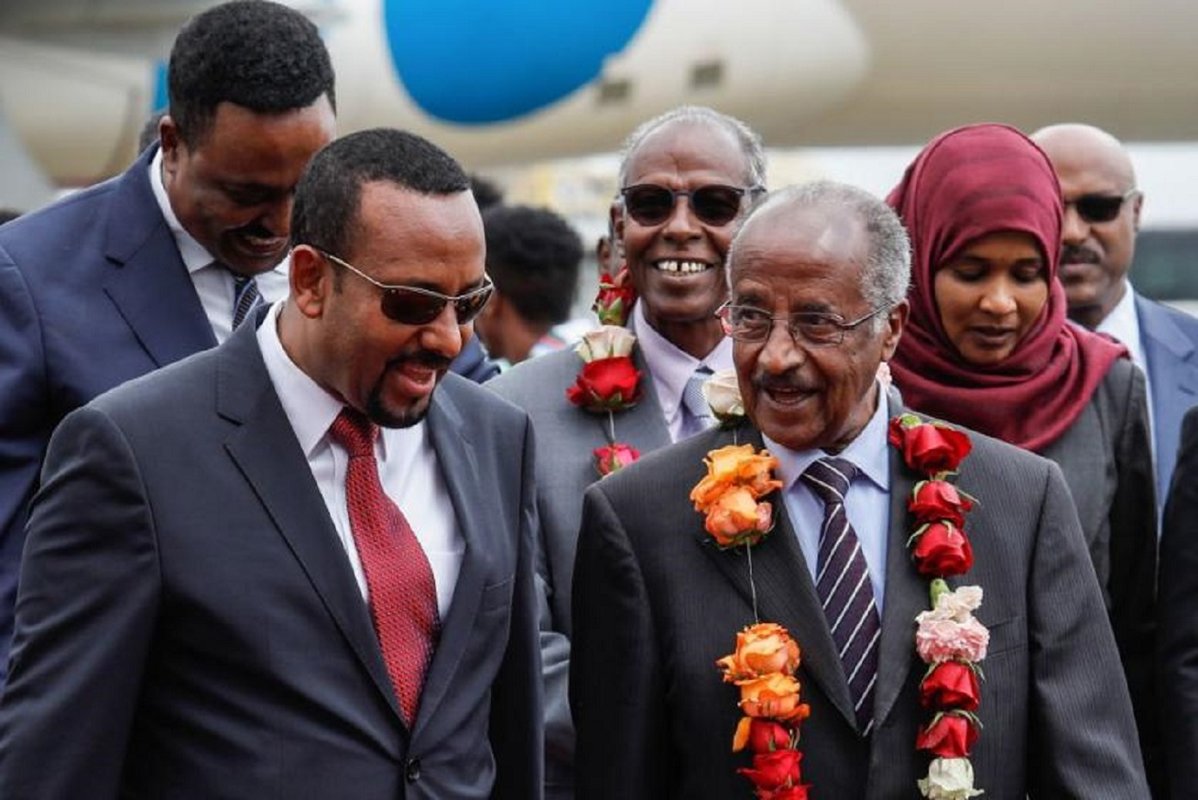 Ethiopia and Eritrea end their war and commit to fresh ties.Peace at last: Eritrea’s Foreign Minister Osman Saleh Mohammed (right) walks with Ethiopia’s Prime Minister Abiy Ahmed (left) after signing a historic peace deal that will end a decades-long conflict between the neighbouring nations.Ethiopia and Eritrea are no longer at war, the neighbours said in a joint statement on Monday, a day after their leaders held a historic meeting in Asmara.
Ethiopia and Eritrea end their war and commit to fresh ties.Peace at last: Eritrea’s Foreign Minister Osman Saleh Mohammed (right) walks with Ethiopia’s Prime Minister Abiy Ahmed (left) after signing a historic peace deal that will end a decades-long conflict between the neighbouring nations.Ethiopia and Eritrea are no longer at war, the neighbours said in a joint statement on Monday, a day after their leaders held a historic meeting in Asmara.
